Business Environment and Organisational Analysis: River Island Report
VerifiedAdded on 2020/10/22
|16
|4734
|203
Report
AI Summary
This report provides a comprehensive analysis of the business environment, focusing on River Island, a UK-based clothing company. The report begins with an introduction to the business environment, including internal and external factors. It then delves into the types and purposes of private, public, and voluntary organizations, using River Island, the NHS, and Oxfam as examples. The report explores the size and scope of these organizations, including their vision, mission, and legal structures. It examines the interrelation between organizational departments and their contribution to objectives, and the impact of micro-environmental factors. The report also includes an internal analysis of River Island, identifying strengths and weaknesses, and explores the interrelation of macro-environmental factors using SWOT and PESTLE analyses. The report concludes with a summary of findings and a list of references.

Business and
Business
Environment
Business
Environment
Paraphrase This Document
Need a fresh take? Get an instant paraphrase of this document with our AI Paraphraser
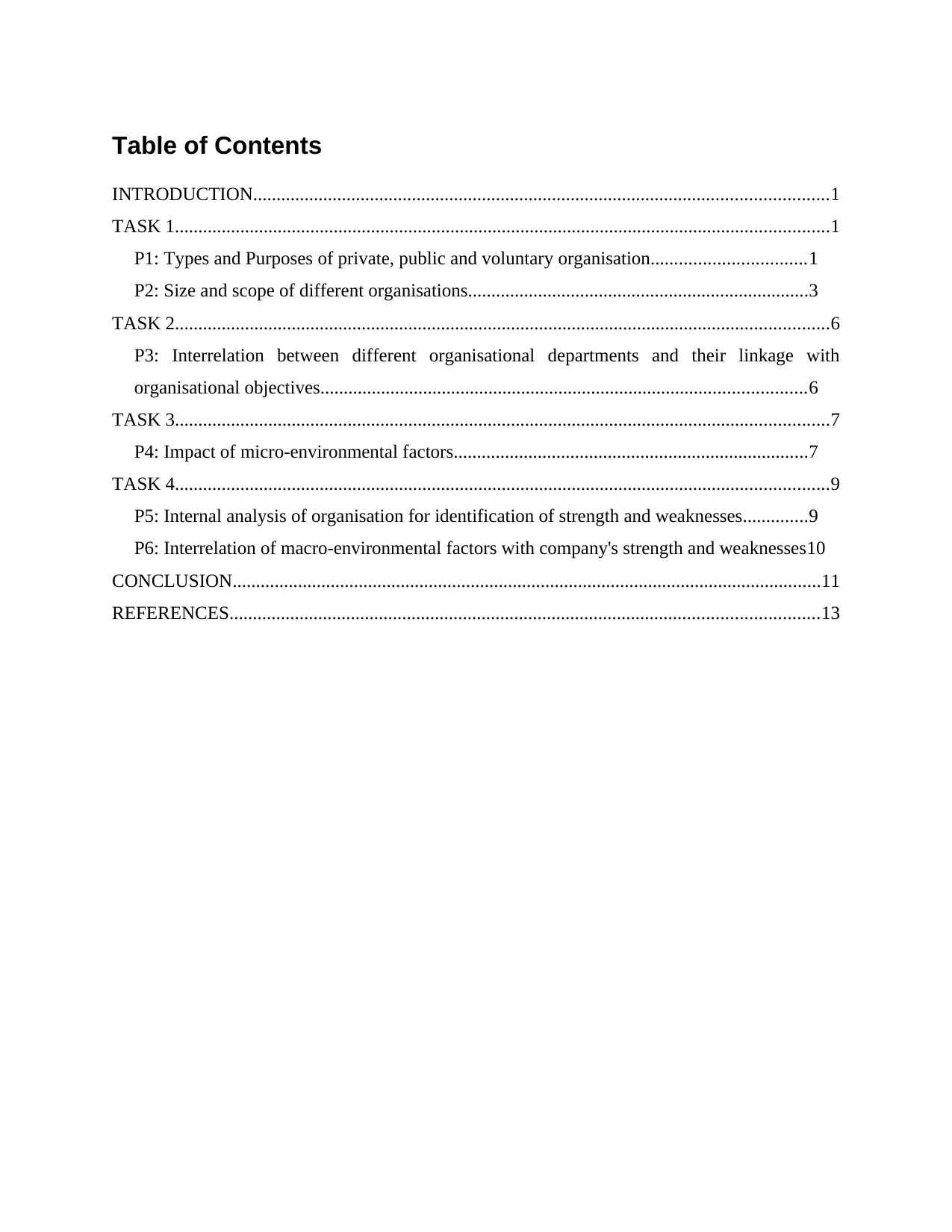
Table of Contents
INTRODUCTION...........................................................................................................................1
TASK 1............................................................................................................................................1
P1: Types and Purposes of private, public and voluntary organisation.................................1
P2: Size and scope of different organisations.........................................................................3
TASK 2............................................................................................................................................6
P3: Interrelation between different organisational departments and their linkage with
organisational objectives........................................................................................................6
TASK 3............................................................................................................................................7
P4: Impact of micro-environmental factors............................................................................7
TASK 4............................................................................................................................................9
P5: Internal analysis of organisation for identification of strength and weaknesses..............9
P6: Interrelation of macro-environmental factors with company's strength and weaknesses10
CONCLUSION..............................................................................................................................11
REFERENCES..............................................................................................................................13
INTRODUCTION...........................................................................................................................1
TASK 1............................................................................................................................................1
P1: Types and Purposes of private, public and voluntary organisation.................................1
P2: Size and scope of different organisations.........................................................................3
TASK 2............................................................................................................................................6
P3: Interrelation between different organisational departments and their linkage with
organisational objectives........................................................................................................6
TASK 3............................................................................................................................................7
P4: Impact of micro-environmental factors............................................................................7
TASK 4............................................................................................................................................9
P5: Internal analysis of organisation for identification of strength and weaknesses..............9
P6: Interrelation of macro-environmental factors with company's strength and weaknesses10
CONCLUSION..............................................................................................................................11
REFERENCES..............................................................................................................................13
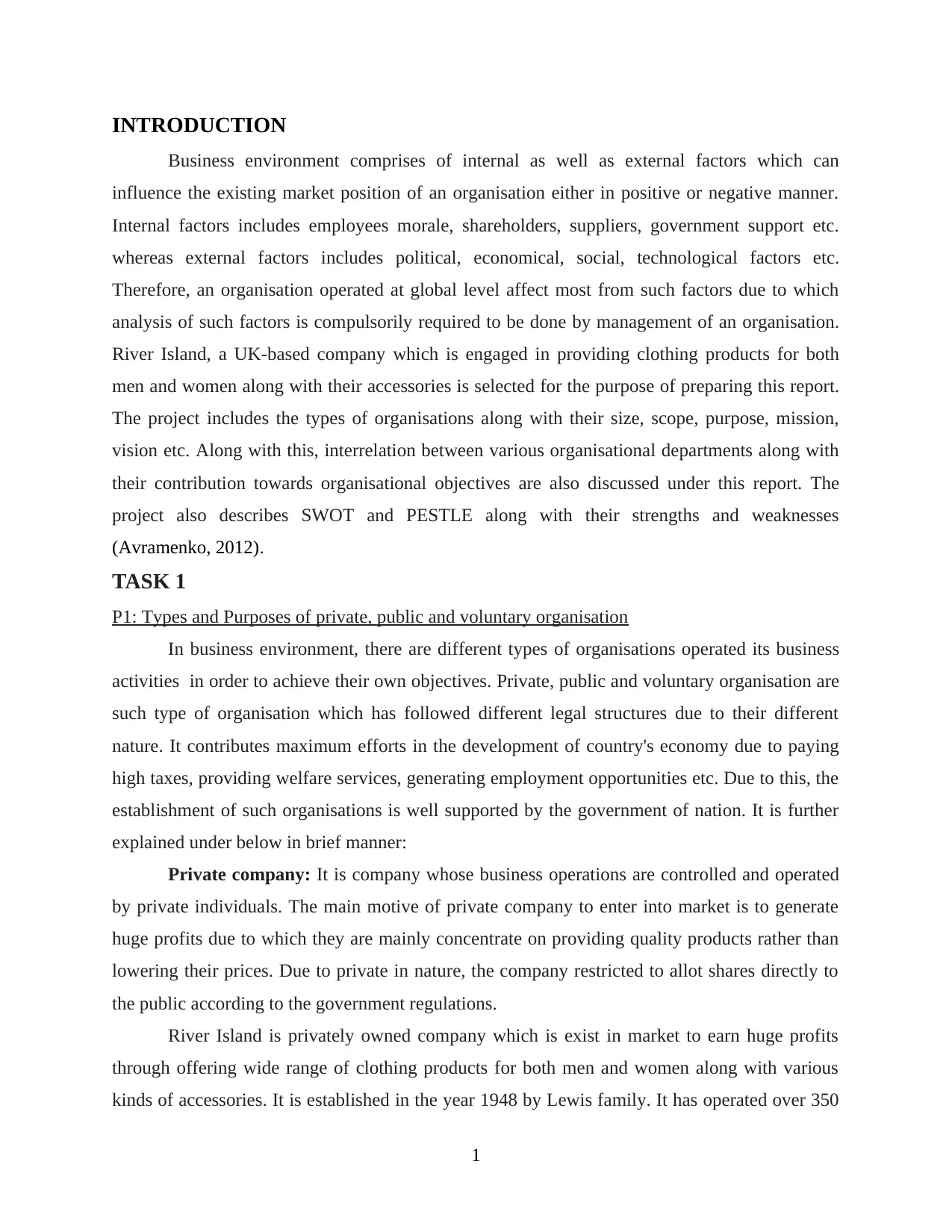
INTRODUCTION
Business environment comprises of internal as well as external factors which can
influence the existing market position of an organisation either in positive or negative manner.
Internal factors includes employees morale, shareholders, suppliers, government support etc.
whereas external factors includes political, economical, social, technological factors etc.
Therefore, an organisation operated at global level affect most from such factors due to which
analysis of such factors is compulsorily required to be done by management of an organisation.
River Island, a UK-based company which is engaged in providing clothing products for both
men and women along with their accessories is selected for the purpose of preparing this report.
The project includes the types of organisations along with their size, scope, purpose, mission,
vision etc. Along with this, interrelation between various organisational departments along with
their contribution towards organisational objectives are also discussed under this report. The
project also describes SWOT and PESTLE along with their strengths and weaknesses
(Avramenko, 2012).
TASK 1
P1: Types and Purposes of private, public and voluntary organisation
In business environment, there are different types of organisations operated its business
activities in order to achieve their own objectives. Private, public and voluntary organisation are
such type of organisation which has followed different legal structures due to their different
nature. It contributes maximum efforts in the development of country's economy due to paying
high taxes, providing welfare services, generating employment opportunities etc. Due to this, the
establishment of such organisations is well supported by the government of nation. It is further
explained under below in brief manner:
Private company: It is company whose business operations are controlled and operated
by private individuals. The main motive of private company to enter into market is to generate
huge profits due to which they are mainly concentrate on providing quality products rather than
lowering their prices. Due to private in nature, the company restricted to allot shares directly to
the public according to the government regulations.
River Island is privately owned company which is exist in market to earn huge profits
through offering wide range of clothing products for both men and women along with various
kinds of accessories. It is established in the year 1948 by Lewis family. It has operated over 350
1
Business environment comprises of internal as well as external factors which can
influence the existing market position of an organisation either in positive or negative manner.
Internal factors includes employees morale, shareholders, suppliers, government support etc.
whereas external factors includes political, economical, social, technological factors etc.
Therefore, an organisation operated at global level affect most from such factors due to which
analysis of such factors is compulsorily required to be done by management of an organisation.
River Island, a UK-based company which is engaged in providing clothing products for both
men and women along with their accessories is selected for the purpose of preparing this report.
The project includes the types of organisations along with their size, scope, purpose, mission,
vision etc. Along with this, interrelation between various organisational departments along with
their contribution towards organisational objectives are also discussed under this report. The
project also describes SWOT and PESTLE along with their strengths and weaknesses
(Avramenko, 2012).
TASK 1
P1: Types and Purposes of private, public and voluntary organisation
In business environment, there are different types of organisations operated its business
activities in order to achieve their own objectives. Private, public and voluntary organisation are
such type of organisation which has followed different legal structures due to their different
nature. It contributes maximum efforts in the development of country's economy due to paying
high taxes, providing welfare services, generating employment opportunities etc. Due to this, the
establishment of such organisations is well supported by the government of nation. It is further
explained under below in brief manner:
Private company: It is company whose business operations are controlled and operated
by private individuals. The main motive of private company to enter into market is to generate
huge profits due to which they are mainly concentrate on providing quality products rather than
lowering their prices. Due to private in nature, the company restricted to allot shares directly to
the public according to the government regulations.
River Island is privately owned company which is exist in market to earn huge profits
through offering wide range of clothing products for both men and women along with various
kinds of accessories. It is established in the year 1948 by Lewis family. It has operated over 350
1
⊘ This is a preview!⊘
Do you want full access?
Subscribe today to unlock all pages.

Trusted by 1+ million students worldwide
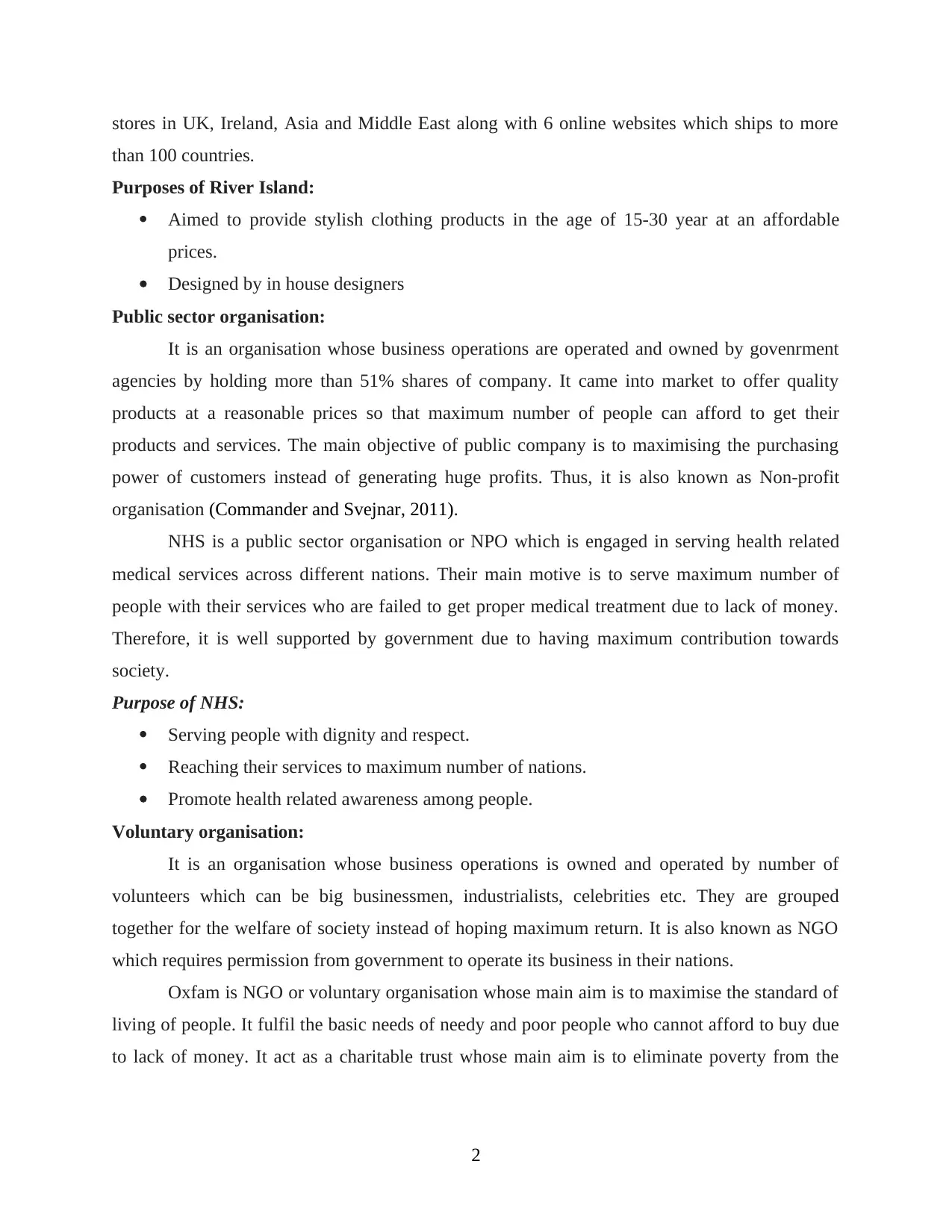
stores in UK, Ireland, Asia and Middle East along with 6 online websites which ships to more
than 100 countries.
Purposes of River Island:
Aimed to provide stylish clothing products in the age of 15-30 year at an affordable
prices.
Designed by in house designers
Public sector organisation:
It is an organisation whose business operations are operated and owned by govenrment
agencies by holding more than 51% shares of company. It came into market to offer quality
products at a reasonable prices so that maximum number of people can afford to get their
products and services. The main objective of public company is to maximising the purchasing
power of customers instead of generating huge profits. Thus, it is also known as Non-profit
organisation (Commander and Svejnar, 2011).
NHS is a public sector organisation or NPO which is engaged in serving health related
medical services across different nations. Their main motive is to serve maximum number of
people with their services who are failed to get proper medical treatment due to lack of money.
Therefore, it is well supported by government due to having maximum contribution towards
society.
Purpose of NHS:
Serving people with dignity and respect.
Reaching their services to maximum number of nations.
Promote health related awareness among people.
Voluntary organisation:
It is an organisation whose business operations is owned and operated by number of
volunteers which can be big businessmen, industrialists, celebrities etc. They are grouped
together for the welfare of society instead of hoping maximum return. It is also known as NGO
which requires permission from government to operate its business in their nations.
Oxfam is NGO or voluntary organisation whose main aim is to maximise the standard of
living of people. It fulfil the basic needs of needy and poor people who cannot afford to buy due
to lack of money. It act as a charitable trust whose main aim is to eliminate poverty from the
2
than 100 countries.
Purposes of River Island:
Aimed to provide stylish clothing products in the age of 15-30 year at an affordable
prices.
Designed by in house designers
Public sector organisation:
It is an organisation whose business operations are operated and owned by govenrment
agencies by holding more than 51% shares of company. It came into market to offer quality
products at a reasonable prices so that maximum number of people can afford to get their
products and services. The main objective of public company is to maximising the purchasing
power of customers instead of generating huge profits. Thus, it is also known as Non-profit
organisation (Commander and Svejnar, 2011).
NHS is a public sector organisation or NPO which is engaged in serving health related
medical services across different nations. Their main motive is to serve maximum number of
people with their services who are failed to get proper medical treatment due to lack of money.
Therefore, it is well supported by government due to having maximum contribution towards
society.
Purpose of NHS:
Serving people with dignity and respect.
Reaching their services to maximum number of nations.
Promote health related awareness among people.
Voluntary organisation:
It is an organisation whose business operations is owned and operated by number of
volunteers which can be big businessmen, industrialists, celebrities etc. They are grouped
together for the welfare of society instead of hoping maximum return. It is also known as NGO
which requires permission from government to operate its business in their nations.
Oxfam is NGO or voluntary organisation whose main aim is to maximise the standard of
living of people. It fulfil the basic needs of needy and poor people who cannot afford to buy due
to lack of money. It act as a charitable trust whose main aim is to eliminate poverty from the
2
Paraphrase This Document
Need a fresh take? Get an instant paraphrase of this document with our AI Paraphraser
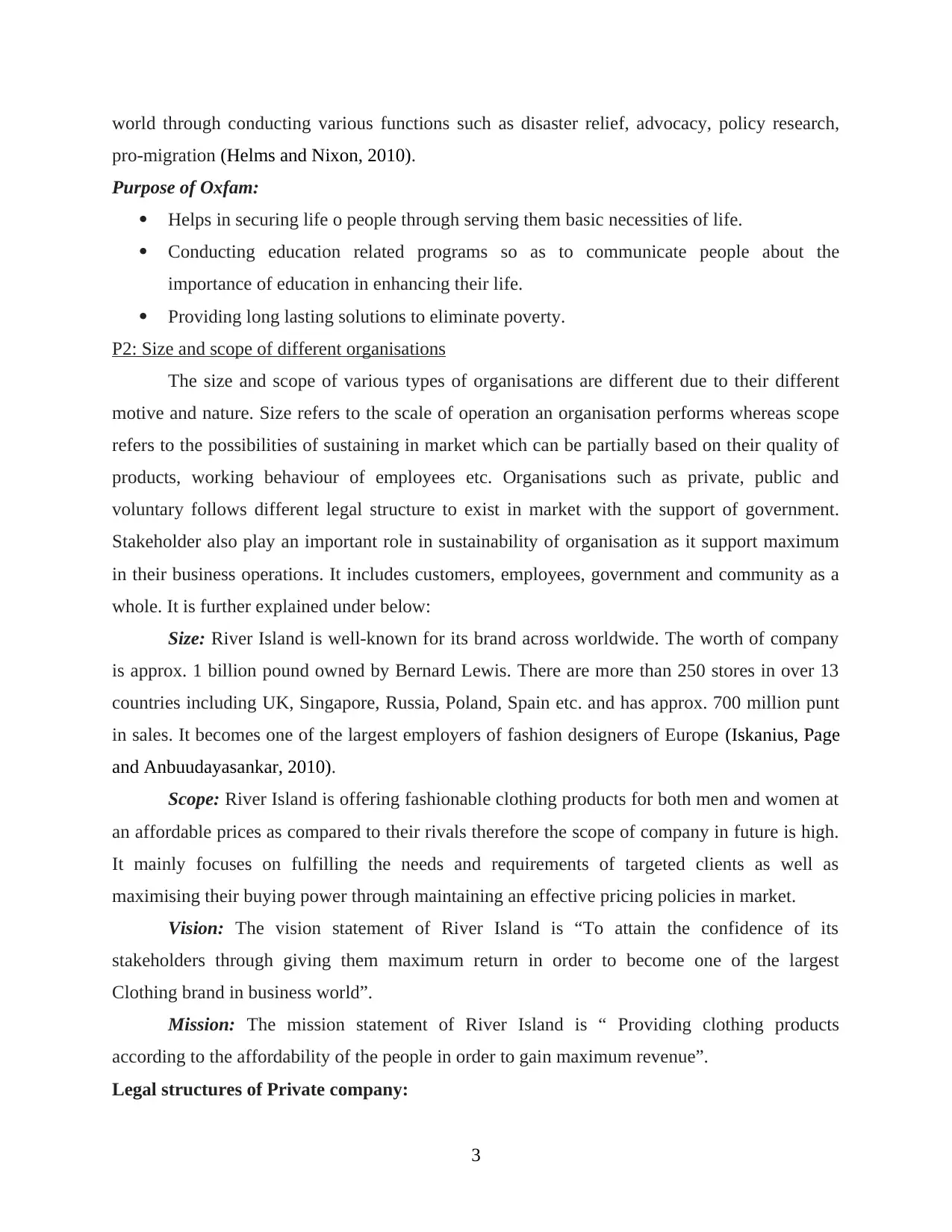
world through conducting various functions such as disaster relief, advocacy, policy research,
pro-migration (Helms and Nixon, 2010).
Purpose of Oxfam:
Helps in securing life o people through serving them basic necessities of life.
Conducting education related programs so as to communicate people about the
importance of education in enhancing their life.
Providing long lasting solutions to eliminate poverty.
P2: Size and scope of different organisations
The size and scope of various types of organisations are different due to their different
motive and nature. Size refers to the scale of operation an organisation performs whereas scope
refers to the possibilities of sustaining in market which can be partially based on their quality of
products, working behaviour of employees etc. Organisations such as private, public and
voluntary follows different legal structure to exist in market with the support of government.
Stakeholder also play an important role in sustainability of organisation as it support maximum
in their business operations. It includes customers, employees, government and community as a
whole. It is further explained under below:
Size: River Island is well-known for its brand across worldwide. The worth of company
is approx. 1 billion pound owned by Bernard Lewis. There are more than 250 stores in over 13
countries including UK, Singapore, Russia, Poland, Spain etc. and has approx. 700 million punt
in sales. It becomes one of the largest employers of fashion designers of Europe (Iskanius, Page
and Anbuudayasankar, 2010).
Scope: River Island is offering fashionable clothing products for both men and women at
an affordable prices as compared to their rivals therefore the scope of company in future is high.
It mainly focuses on fulfilling the needs and requirements of targeted clients as well as
maximising their buying power through maintaining an effective pricing policies in market.
Vision: The vision statement of River Island is “To attain the confidence of its
stakeholders through giving them maximum return in order to become one of the largest
Clothing brand in business world”.
Mission: The mission statement of River Island is “ Providing clothing products
according to the affordability of the people in order to gain maximum revenue”.
Legal structures of Private company:
3
pro-migration (Helms and Nixon, 2010).
Purpose of Oxfam:
Helps in securing life o people through serving them basic necessities of life.
Conducting education related programs so as to communicate people about the
importance of education in enhancing their life.
Providing long lasting solutions to eliminate poverty.
P2: Size and scope of different organisations
The size and scope of various types of organisations are different due to their different
motive and nature. Size refers to the scale of operation an organisation performs whereas scope
refers to the possibilities of sustaining in market which can be partially based on their quality of
products, working behaviour of employees etc. Organisations such as private, public and
voluntary follows different legal structure to exist in market with the support of government.
Stakeholder also play an important role in sustainability of organisation as it support maximum
in their business operations. It includes customers, employees, government and community as a
whole. It is further explained under below:
Size: River Island is well-known for its brand across worldwide. The worth of company
is approx. 1 billion pound owned by Bernard Lewis. There are more than 250 stores in over 13
countries including UK, Singapore, Russia, Poland, Spain etc. and has approx. 700 million punt
in sales. It becomes one of the largest employers of fashion designers of Europe (Iskanius, Page
and Anbuudayasankar, 2010).
Scope: River Island is offering fashionable clothing products for both men and women at
an affordable prices as compared to their rivals therefore the scope of company in future is high.
It mainly focuses on fulfilling the needs and requirements of targeted clients as well as
maximising their buying power through maintaining an effective pricing policies in market.
Vision: The vision statement of River Island is “To attain the confidence of its
stakeholders through giving them maximum return in order to become one of the largest
Clothing brand in business world”.
Mission: The mission statement of River Island is “ Providing clothing products
according to the affordability of the people in order to gain maximum revenue”.
Legal structures of Private company:
3
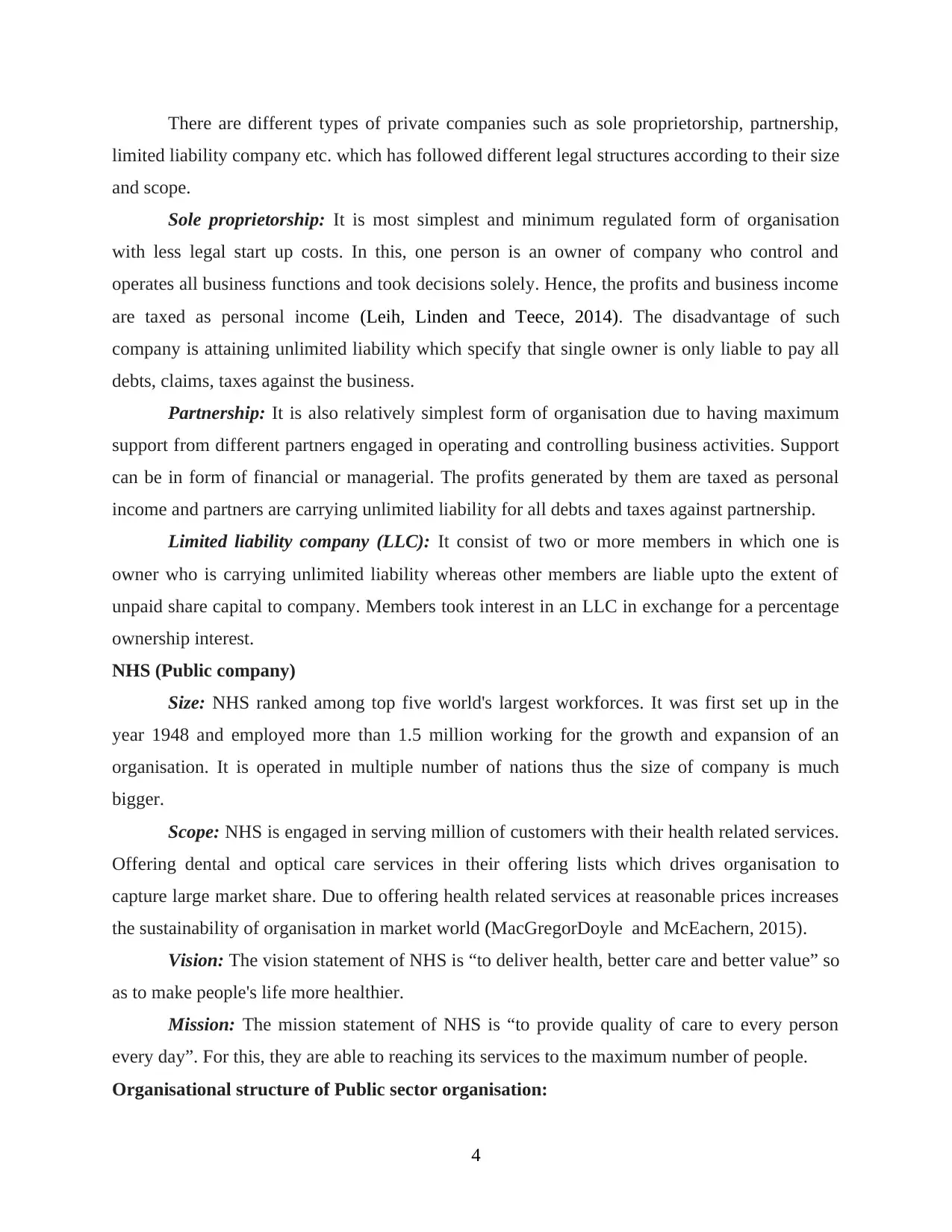
There are different types of private companies such as sole proprietorship, partnership,
limited liability company etc. which has followed different legal structures according to their size
and scope.
Sole proprietorship: It is most simplest and minimum regulated form of organisation
with less legal start up costs. In this, one person is an owner of company who control and
operates all business functions and took decisions solely. Hence, the profits and business income
are taxed as personal income (Leih, Linden and Teece, 2014). The disadvantage of such
company is attaining unlimited liability which specify that single owner is only liable to pay all
debts, claims, taxes against the business.
Partnership: It is also relatively simplest form of organisation due to having maximum
support from different partners engaged in operating and controlling business activities. Support
can be in form of financial or managerial. The profits generated by them are taxed as personal
income and partners are carrying unlimited liability for all debts and taxes against partnership.
Limited liability company (LLC): It consist of two or more members in which one is
owner who is carrying unlimited liability whereas other members are liable upto the extent of
unpaid share capital to company. Members took interest in an LLC in exchange for a percentage
ownership interest.
NHS (Public company)
Size: NHS ranked among top five world's largest workforces. It was first set up in the
year 1948 and employed more than 1.5 million working for the growth and expansion of an
organisation. It is operated in multiple number of nations thus the size of company is much
bigger.
Scope: NHS is engaged in serving million of customers with their health related services.
Offering dental and optical care services in their offering lists which drives organisation to
capture large market share. Due to offering health related services at reasonable prices increases
the sustainability of organisation in market world (MacGregorDoyle and McEachern, 2015).
Vision: The vision statement of NHS is “to deliver health, better care and better value” so
as to make people's life more healthier.
Mission: The mission statement of NHS is “to provide quality of care to every person
every day”. For this, they are able to reaching its services to the maximum number of people.
Organisational structure of Public sector organisation:
4
limited liability company etc. which has followed different legal structures according to their size
and scope.
Sole proprietorship: It is most simplest and minimum regulated form of organisation
with less legal start up costs. In this, one person is an owner of company who control and
operates all business functions and took decisions solely. Hence, the profits and business income
are taxed as personal income (Leih, Linden and Teece, 2014). The disadvantage of such
company is attaining unlimited liability which specify that single owner is only liable to pay all
debts, claims, taxes against the business.
Partnership: It is also relatively simplest form of organisation due to having maximum
support from different partners engaged in operating and controlling business activities. Support
can be in form of financial or managerial. The profits generated by them are taxed as personal
income and partners are carrying unlimited liability for all debts and taxes against partnership.
Limited liability company (LLC): It consist of two or more members in which one is
owner who is carrying unlimited liability whereas other members are liable upto the extent of
unpaid share capital to company. Members took interest in an LLC in exchange for a percentage
ownership interest.
NHS (Public company)
Size: NHS ranked among top five world's largest workforces. It was first set up in the
year 1948 and employed more than 1.5 million working for the growth and expansion of an
organisation. It is operated in multiple number of nations thus the size of company is much
bigger.
Scope: NHS is engaged in serving million of customers with their health related services.
Offering dental and optical care services in their offering lists which drives organisation to
capture large market share. Due to offering health related services at reasonable prices increases
the sustainability of organisation in market world (MacGregorDoyle and McEachern, 2015).
Vision: The vision statement of NHS is “to deliver health, better care and better value” so
as to make people's life more healthier.
Mission: The mission statement of NHS is “to provide quality of care to every person
every day”. For this, they are able to reaching its services to the maximum number of people.
Organisational structure of Public sector organisation:
4
⊘ This is a preview!⊘
Do you want full access?
Subscribe today to unlock all pages.

Trusted by 1+ million students worldwide
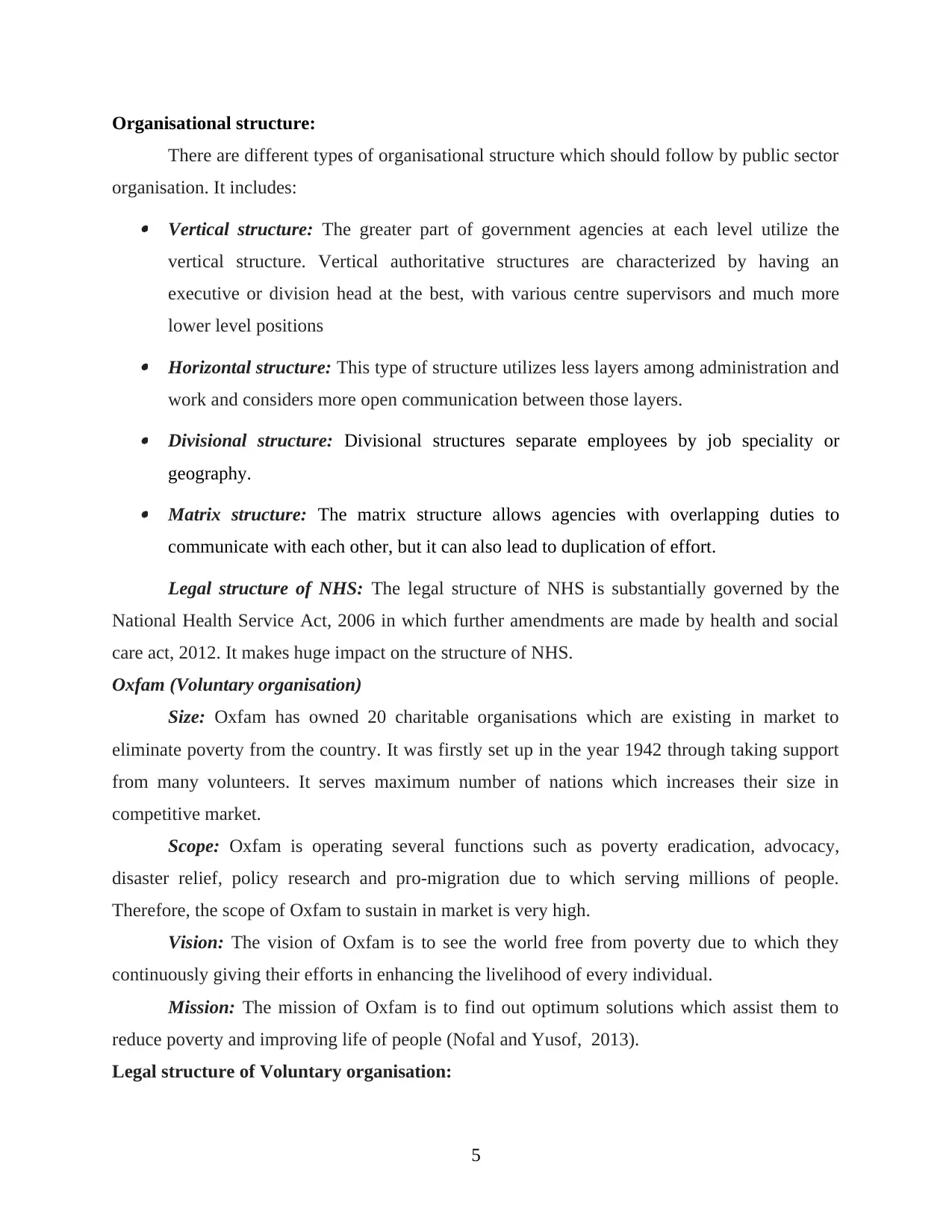
Organisational structure:
There are different types of organisational structure which should follow by public sector
organisation. It includes: Vertical structure: The greater part of government agencies at each level utilize the
vertical structure. Vertical authoritative structures are characterized by having an
executive or division head at the best, with various centre supervisors and much more
lower level positions Horizontal structure: This type of structure utilizes less layers among administration and
work and considers more open communication between those layers. Divisional structure: Divisional structures separate employees by job speciality or
geography. Matrix structure: The matrix structure allows agencies with overlapping duties to
communicate with each other, but it can also lead to duplication of effort.
Legal structure of NHS: The legal structure of NHS is substantially governed by the
National Health Service Act, 2006 in which further amendments are made by health and social
care act, 2012. It makes huge impact on the structure of NHS.
Oxfam (Voluntary organisation)
Size: Oxfam has owned 20 charitable organisations which are existing in market to
eliminate poverty from the country. It was firstly set up in the year 1942 through taking support
from many volunteers. It serves maximum number of nations which increases their size in
competitive market.
Scope: Oxfam is operating several functions such as poverty eradication, advocacy,
disaster relief, policy research and pro-migration due to which serving millions of people.
Therefore, the scope of Oxfam to sustain in market is very high.
Vision: The vision of Oxfam is to see the world free from poverty due to which they
continuously giving their efforts in enhancing the livelihood of every individual.
Mission: The mission of Oxfam is to find out optimum solutions which assist them to
reduce poverty and improving life of people (Nofal and Yusof, 2013).
Legal structure of Voluntary organisation:
5
There are different types of organisational structure which should follow by public sector
organisation. It includes: Vertical structure: The greater part of government agencies at each level utilize the
vertical structure. Vertical authoritative structures are characterized by having an
executive or division head at the best, with various centre supervisors and much more
lower level positions Horizontal structure: This type of structure utilizes less layers among administration and
work and considers more open communication between those layers. Divisional structure: Divisional structures separate employees by job speciality or
geography. Matrix structure: The matrix structure allows agencies with overlapping duties to
communicate with each other, but it can also lead to duplication of effort.
Legal structure of NHS: The legal structure of NHS is substantially governed by the
National Health Service Act, 2006 in which further amendments are made by health and social
care act, 2012. It makes huge impact on the structure of NHS.
Oxfam (Voluntary organisation)
Size: Oxfam has owned 20 charitable organisations which are existing in market to
eliminate poverty from the country. It was firstly set up in the year 1942 through taking support
from many volunteers. It serves maximum number of nations which increases their size in
competitive market.
Scope: Oxfam is operating several functions such as poverty eradication, advocacy,
disaster relief, policy research and pro-migration due to which serving millions of people.
Therefore, the scope of Oxfam to sustain in market is very high.
Vision: The vision of Oxfam is to see the world free from poverty due to which they
continuously giving their efforts in enhancing the livelihood of every individual.
Mission: The mission of Oxfam is to find out optimum solutions which assist them to
reduce poverty and improving life of people (Nofal and Yusof, 2013).
Legal structure of Voluntary organisation:
5
Paraphrase This Document
Need a fresh take? Get an instant paraphrase of this document with our AI Paraphraser
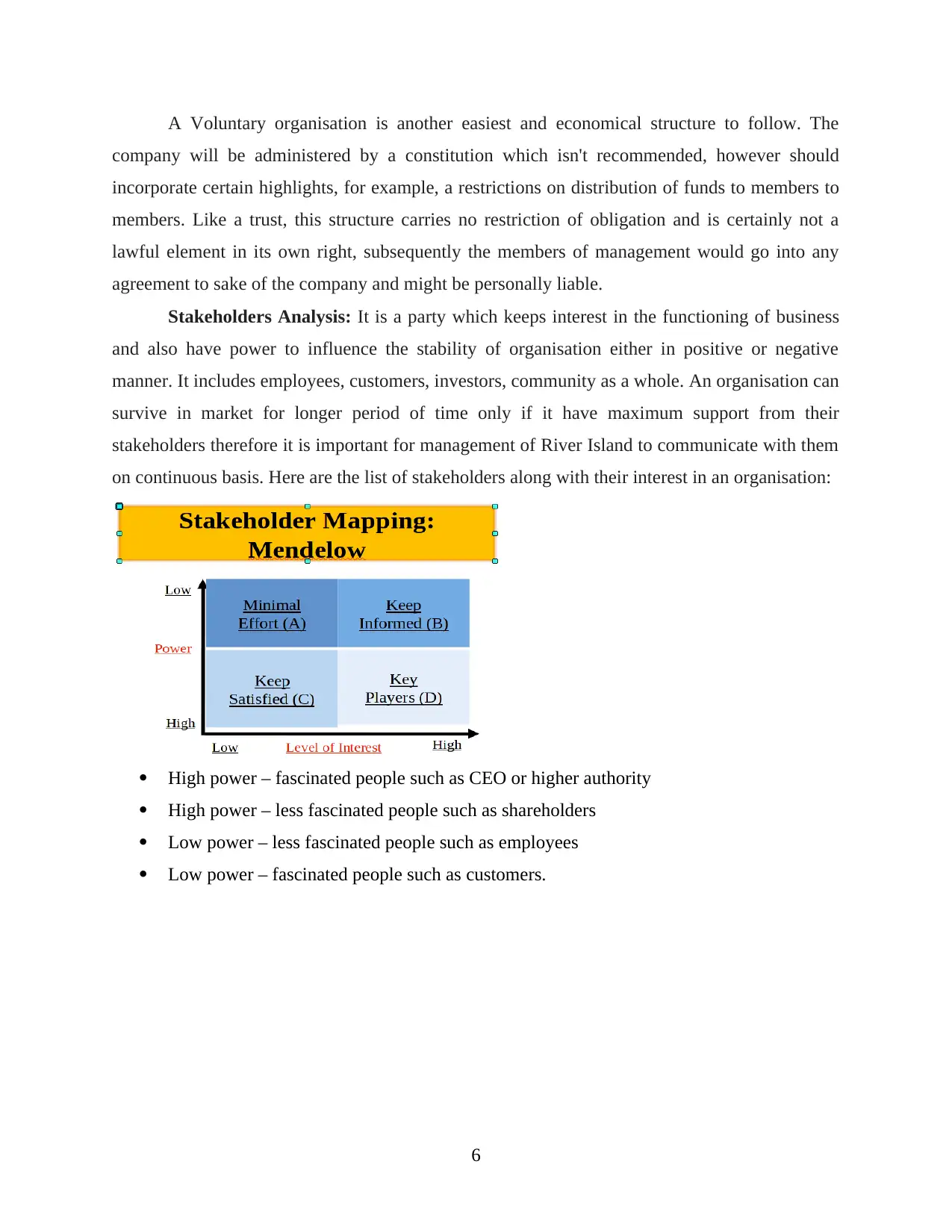
A Voluntary organisation is another easiest and economical structure to follow. The
company will be administered by a constitution which isn't recommended, however should
incorporate certain highlights, for example, a restrictions on distribution of funds to members to
members. Like a trust, this structure carries no restriction of obligation and is certainly not a
lawful element in its own right, subsequently the members of management would go into any
agreement to sake of the company and might be personally liable.
Stakeholders Analysis: It is a party which keeps interest in the functioning of business
and also have power to influence the stability of organisation either in positive or negative
manner. It includes employees, customers, investors, community as a whole. An organisation can
survive in market for longer period of time only if it have maximum support from their
stakeholders therefore it is important for management of River Island to communicate with them
on continuous basis. Here are the list of stakeholders along with their interest in an organisation:
High power – fascinated people such as CEO or higher authority
High power – less fascinated people such as shareholders
Low power – less fascinated people such as employees
Low power – fascinated people such as customers.
6
company will be administered by a constitution which isn't recommended, however should
incorporate certain highlights, for example, a restrictions on distribution of funds to members to
members. Like a trust, this structure carries no restriction of obligation and is certainly not a
lawful element in its own right, subsequently the members of management would go into any
agreement to sake of the company and might be personally liable.
Stakeholders Analysis: It is a party which keeps interest in the functioning of business
and also have power to influence the stability of organisation either in positive or negative
manner. It includes employees, customers, investors, community as a whole. An organisation can
survive in market for longer period of time only if it have maximum support from their
stakeholders therefore it is important for management of River Island to communicate with them
on continuous basis. Here are the list of stakeholders along with their interest in an organisation:
High power – fascinated people such as CEO or higher authority
High power – less fascinated people such as shareholders
Low power – less fascinated people such as employees
Low power – fascinated people such as customers.
6

TASK 2
P3: Interrelation between different organisational departments and their linkage with
organisational objectives
Illustration 1: Organisational Chart of Company
Source: Organisational Chart of Company, 2013
Source: Organisational Chart, 2018
Source: Divisional Organisation Structure, 2018
The contribution of different departments of an organisation play an important role in
achieving growth and success in competitive market. Such departments includes marketing,
7
Illustration 2: Organisational chart
P3: Interrelation between different organisational departments and their linkage with
organisational objectives
Illustration 1: Organisational Chart of Company
Source: Organisational Chart of Company, 2013
Source: Organisational Chart, 2018
Source: Divisional Organisation Structure, 2018
The contribution of different departments of an organisation play an important role in
achieving growth and success in competitive market. Such departments includes marketing,
7
Illustration 2: Organisational chart
⊘ This is a preview!⊘
Do you want full access?
Subscribe today to unlock all pages.

Trusted by 1+ million students worldwide

finance, human resource, IT etc. The top authority of organisation including shareholders, CEO
and Board of Directors are liable to manage and monitor business functions through assigning
roles and responsibilities to each department on the basis of their nature so as to gain maximum
contribution from them in achieving competitive advantage. A multinational organisations such
as River Island need to understand the value of their departments which is further explained as
under:
HR Department: It is the department which is perform different roles and responsibilities
such as recruitment of employees, appraisal of performance, fixation of salaries etc. Under this,
HR manager is held responsible to increase the performance level of workforce through giving
them recognition, rewards, compensation etc. To recruit skilled employees, it requires maximum
support from the marketing department in order to attract lots of job applicants through using
various marketing techniques such as social media, Newspapers etc. Combined efforts of both
department drives company to achieve higher profitability in future period of time (Osterwalder
and Pigneur, 2010).
Finance department: It is a department who is responsible to help company in
maintaining their financial position in market through managing and raising funds from different
sources such as financial institutions, banks etc. It drives other departments to execute their
business activities in more effective and efficient manner. For an instance, production
department of River Island requires financial support in acquiring advanced and updated
equipments used in production process so that quality product can be produced. Therefore, all
other departments are very much dependent on finance department in execution of business
activities which in results higher profitability and sustainability.
Marketing department: It is a department who is responsible to promote brand of
company at global level which requires proper marketing planning. For this, marketing manager
is required to prepare marketing budget after analysing the availability of funds with company at
present times. Therefore, it requires maximum support of finance department to execute
marketing planned activities in more effective and efficient manner. Both such departments of
River Island are very much supported in achieving the organisational objectives.
IT department: It is a department who is responsible to record all information related
with performance of employees, funds invested by other departments. It help management of
River Island in making an effective decision for further actions. IT department help HR
8
and Board of Directors are liable to manage and monitor business functions through assigning
roles and responsibilities to each department on the basis of their nature so as to gain maximum
contribution from them in achieving competitive advantage. A multinational organisations such
as River Island need to understand the value of their departments which is further explained as
under:
HR Department: It is the department which is perform different roles and responsibilities
such as recruitment of employees, appraisal of performance, fixation of salaries etc. Under this,
HR manager is held responsible to increase the performance level of workforce through giving
them recognition, rewards, compensation etc. To recruit skilled employees, it requires maximum
support from the marketing department in order to attract lots of job applicants through using
various marketing techniques such as social media, Newspapers etc. Combined efforts of both
department drives company to achieve higher profitability in future period of time (Osterwalder
and Pigneur, 2010).
Finance department: It is a department who is responsible to help company in
maintaining their financial position in market through managing and raising funds from different
sources such as financial institutions, banks etc. It drives other departments to execute their
business activities in more effective and efficient manner. For an instance, production
department of River Island requires financial support in acquiring advanced and updated
equipments used in production process so that quality product can be produced. Therefore, all
other departments are very much dependent on finance department in execution of business
activities which in results higher profitability and sustainability.
Marketing department: It is a department who is responsible to promote brand of
company at global level which requires proper marketing planning. For this, marketing manager
is required to prepare marketing budget after analysing the availability of funds with company at
present times. Therefore, it requires maximum support of finance department to execute
marketing planned activities in more effective and efficient manner. Both such departments of
River Island are very much supported in achieving the organisational objectives.
IT department: It is a department who is responsible to record all information related
with performance of employees, funds invested by other departments. It help management of
River Island in making an effective decision for further actions. IT department help HR
8
Paraphrase This Document
Need a fresh take? Get an instant paraphrase of this document with our AI Paraphraser
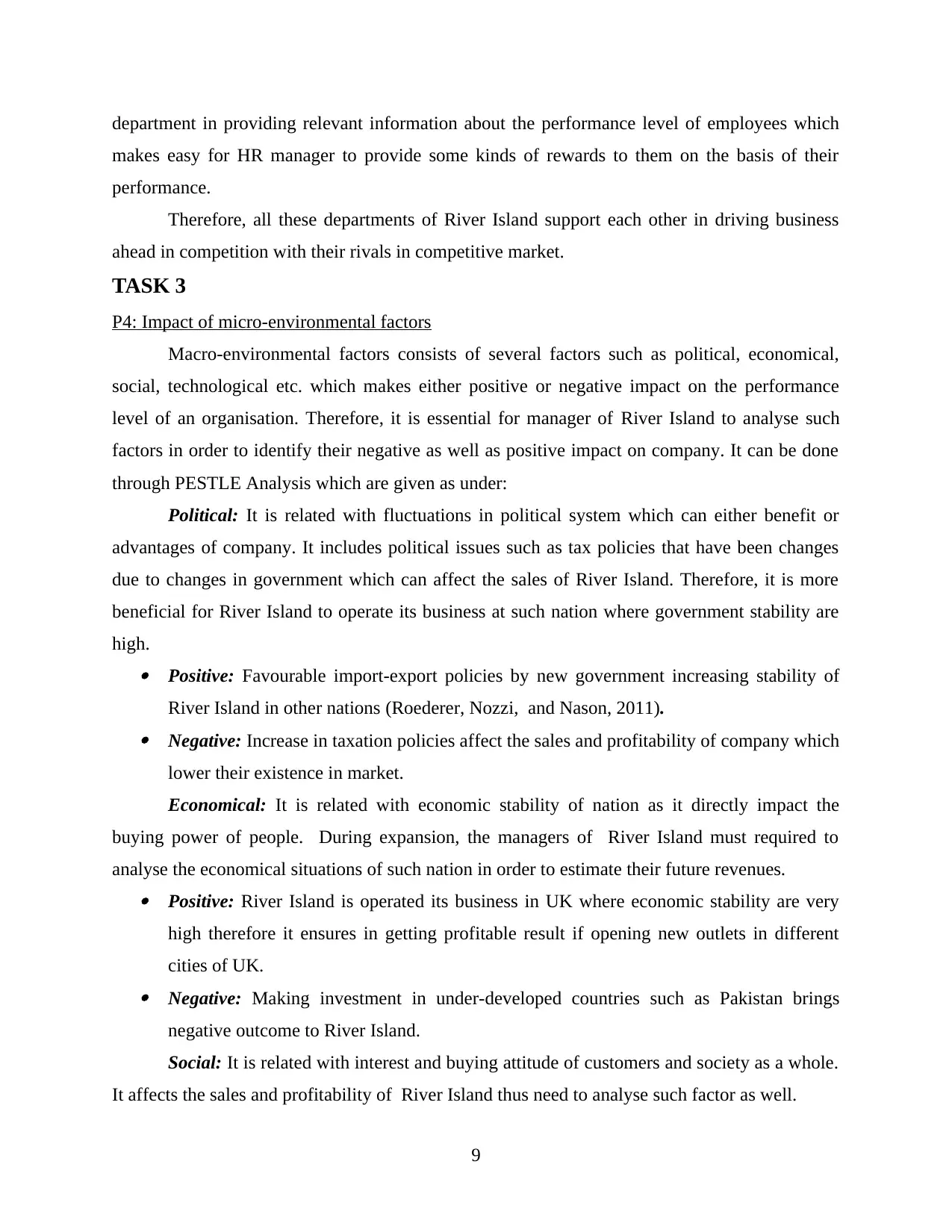
department in providing relevant information about the performance level of employees which
makes easy for HR manager to provide some kinds of rewards to them on the basis of their
performance.
Therefore, all these departments of River Island support each other in driving business
ahead in competition with their rivals in competitive market.
TASK 3
P4: Impact of micro-environmental factors
Macro-environmental factors consists of several factors such as political, economical,
social, technological etc. which makes either positive or negative impact on the performance
level of an organisation. Therefore, it is essential for manager of River Island to analyse such
factors in order to identify their negative as well as positive impact on company. It can be done
through PESTLE Analysis which are given as under:
Political: It is related with fluctuations in political system which can either benefit or
advantages of company. It includes political issues such as tax policies that have been changes
due to changes in government which can affect the sales of River Island. Therefore, it is more
beneficial for River Island to operate its business at such nation where government stability are
high. Positive: Favourable import-export policies by new government increasing stability of
River Island in other nations (Roederer, Nozzi, and Nason, 2011). Negative: Increase in taxation policies affect the sales and profitability of company which
lower their existence in market.
Economical: It is related with economic stability of nation as it directly impact the
buying power of people. During expansion, the managers of River Island must required to
analyse the economical situations of such nation in order to estimate their future revenues. Positive: River Island is operated its business in UK where economic stability are very
high therefore it ensures in getting profitable result if opening new outlets in different
cities of UK. Negative: Making investment in under-developed countries such as Pakistan brings
negative outcome to River Island.
Social: It is related with interest and buying attitude of customers and society as a whole.
It affects the sales and profitability of River Island thus need to analyse such factor as well.
9
makes easy for HR manager to provide some kinds of rewards to them on the basis of their
performance.
Therefore, all these departments of River Island support each other in driving business
ahead in competition with their rivals in competitive market.
TASK 3
P4: Impact of micro-environmental factors
Macro-environmental factors consists of several factors such as political, economical,
social, technological etc. which makes either positive or negative impact on the performance
level of an organisation. Therefore, it is essential for manager of River Island to analyse such
factors in order to identify their negative as well as positive impact on company. It can be done
through PESTLE Analysis which are given as under:
Political: It is related with fluctuations in political system which can either benefit or
advantages of company. It includes political issues such as tax policies that have been changes
due to changes in government which can affect the sales of River Island. Therefore, it is more
beneficial for River Island to operate its business at such nation where government stability are
high. Positive: Favourable import-export policies by new government increasing stability of
River Island in other nations (Roederer, Nozzi, and Nason, 2011). Negative: Increase in taxation policies affect the sales and profitability of company which
lower their existence in market.
Economical: It is related with economic stability of nation as it directly impact the
buying power of people. During expansion, the managers of River Island must required to
analyse the economical situations of such nation in order to estimate their future revenues. Positive: River Island is operated its business in UK where economic stability are very
high therefore it ensures in getting profitable result if opening new outlets in different
cities of UK. Negative: Making investment in under-developed countries such as Pakistan brings
negative outcome to River Island.
Social: It is related with interest and buying attitude of customers and society as a whole.
It affects the sales and profitability of River Island thus need to analyse such factor as well.
9

Positive: Stylish clothing products at an affordable prices offered by River Island
automatically maximises the interest and buying behaviour of customers which in results
increasing their revenue (Savrul, Incekara, and Sener, 2014). Negative: Having average quality clothing product offered by River Island may failed to
attract higher income people as they prefer quality over price.
Technological: It is related with technological advancement which requires cost to
implement but ensures in getting maximum return in near future thus requires River Island to
analyse such factor. Positive: Making investment in updating existing technology increases sales and
minimising the wastage of funds. For example, Adopting e-commerce for online selling
increases sales as well as customer strength. Negative: It requires huge cost in up-gradation thus if failed to implement effectively the
bring negative outcome to company.
Legal: It is related with legal laws and legislations which affect the existence of company
as well as influences working behaviour of employees thus need to be analysed such factor by
River Island. Positive: Implementing employment acts such as Equal right act etc. maximises the
working behaviour of employees which in results getting maximum contribution from
them. Negative: River Island may face huge penalties by government in terms of non-
compliance of such acts.
Environmental: It is related with environmental laws which can protect the environment
from business operations thus required to analyse such factor by River Island to build good
image in market (Zikmund, and et. al., 2013) Positive: Using environmental friendlily equipments minimising the wastage which
directly protect environment.
Negative: The existence of River Island may comes into danger if negatively affect the
environment due to this production process.
10
automatically maximises the interest and buying behaviour of customers which in results
increasing their revenue (Savrul, Incekara, and Sener, 2014). Negative: Having average quality clothing product offered by River Island may failed to
attract higher income people as they prefer quality over price.
Technological: It is related with technological advancement which requires cost to
implement but ensures in getting maximum return in near future thus requires River Island to
analyse such factor. Positive: Making investment in updating existing technology increases sales and
minimising the wastage of funds. For example, Adopting e-commerce for online selling
increases sales as well as customer strength. Negative: It requires huge cost in up-gradation thus if failed to implement effectively the
bring negative outcome to company.
Legal: It is related with legal laws and legislations which affect the existence of company
as well as influences working behaviour of employees thus need to be analysed such factor by
River Island. Positive: Implementing employment acts such as Equal right act etc. maximises the
working behaviour of employees which in results getting maximum contribution from
them. Negative: River Island may face huge penalties by government in terms of non-
compliance of such acts.
Environmental: It is related with environmental laws which can protect the environment
from business operations thus required to analyse such factor by River Island to build good
image in market (Zikmund, and et. al., 2013) Positive: Using environmental friendlily equipments minimising the wastage which
directly protect environment.
Negative: The existence of River Island may comes into danger if negatively affect the
environment due to this production process.
10
⊘ This is a preview!⊘
Do you want full access?
Subscribe today to unlock all pages.

Trusted by 1+ million students worldwide
1 out of 16
Related Documents
Your All-in-One AI-Powered Toolkit for Academic Success.
+13062052269
info@desklib.com
Available 24*7 on WhatsApp / Email
![[object Object]](/_next/static/media/star-bottom.7253800d.svg)
Unlock your academic potential
Copyright © 2020–2025 A2Z Services. All Rights Reserved. Developed and managed by ZUCOL.





